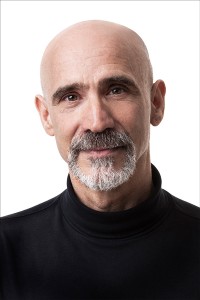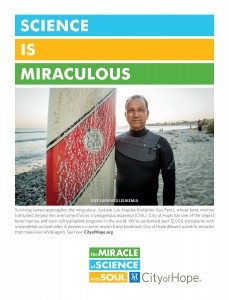Personalized Marketing: Tracking City of Hope’s Impact, One Life at a Time
// By Lisa D. Ellis //
 When a young woman named Kommah was diagnosed with an aggressive form of breast cancer, she was told she had just a 5 percent chance of surviving. Gus, a firefighter, had to forgo saving others’ lives to focus on his own fight against leukemia. Today, both Kommah and Gus have beaten the odds, thanks to care they received through City of Hope, a world-renowned medical research and treatment center just outside of Los Angeles, California. Better yet, both of them have not only survived; they are thriving.
When a young woman named Kommah was diagnosed with an aggressive form of breast cancer, she was told she had just a 5 percent chance of surviving. Gus, a firefighter, had to forgo saving others’ lives to focus on his own fight against leukemia. Today, both Kommah and Gus have beaten the odds, thanks to care they received through City of Hope, a world-renowned medical research and treatment center just outside of Los Angeles, California. Better yet, both of them have not only survived; they are thriving.
Finding the Human Angle
These are just two of the many success stories that City of Hope uses to illustrate the power of combining cutting-edge research with clinicians who care to achieve amazing outcomes. This personalized marketing approach is part of an innovative multidisciplinary campaign called the “Miracle of Science with Soul.”
Last year, Strategic Health Care Marketing featured the launch of this campaign, which is geared to educate people in the Greater Los Angeles area and beyond, about the groundbreaking research under way at City of Hope and the innovative treatment methods offered there to fight cancer and other serious diseases. Recently, we circled back to look at the effectiveness of the campaign’s approach and to find out how it is reaching the people who can benefit from its discoveries and treatment, as well as engaging with donors to support its efforts.
Science Plus Soul Equals Miracles

Lisa Stockmon, chief marketing and communications officer for City of Hope
What we learned from Lisa Stockmon, chief marketing and communications officer for City of Hope, and Andy Semons, partner and head of strategy at Interplanetary, Inc., the advertising agency that created the campaign, is that since its inception the Miracle of Science with Soul campaign has focused on positioning City of Hope as a world leader in the research and treatment of cancer, diabetes, and other serious diseases. And the City of Hope story is being told by the actual people who both have shaped and benefited from its discoveries, which brings the messages home in a very powerful way.
To understand the goals of the campaign, it helps to go back to the medical center’s early days. City of Hope was founded more than 100 years ago, and since then has become known as a leading cancer research and treatment center. It is also one of a group of just 48 comprehensive cancer centers designated by the National Cancer Institute.
What makes City of Hope unique is that its researchers are discovering innovative ways to treat different types of cancer (some which are very rare) and to give people, many of whom have received terminal diagnoses elsewhere, a second chance at life. Yet building awareness of City of Hope discoveries has been difficult in the highly competitive Los Angeles market. But the organization recognized an opportunity to connect with audiences and build awareness in a more impactful, meaningful way.
Helping a Brand Stand Out
“City of Hope felt we were not getting credit for our medical discoveries, and we wanted to increase awareness of our impact on people around the world,” Stockmon says.
The Miracle of Science with Soul campaign was developed in an effort to help City of Hope become more visible, attract a larger audience, and convey something few understood—that City of Hope has a long history of scientific innovation, turning discoveries into treatments that were nothing short of medical miracles.

Andy Semons, partner and head of strategy at Interplanetary, Inc.
“What we discovered when we did research was that two things typically drive patients, donors, and caregivers when they choose a treatment facility—they want compassion and cutting-edge science that will make patients well. The notion of ‘The Miracle of Science with Soul’ was a perfect fit. It’s almost like a math equation. When you add science together with soul or compassion, you get incredible outcomes. Lives are getting saved and that’s truly a miracle,” says Semons.
“The campaign launched in mid-2015. It has run consistently since then,” he says. “The Miracle of Science with Soul (framework) has given City of Hope the opportunity to tell many different stories from many different angles. The campaign was set up to rotate different patient stories and doctor narratives every few months. There is always something new to talk about that keeps the campaign fresh,” he adds.
Letting Patients and Staff Do the Talking
One of the things the campaign tries to accomplish is taking scientific information and bringing it down to the personal level. “When you’re talking about science, it can seem very cold. We mitigate that by making it very human, offering a human point of view,” Semons says.

Gus is an L.A.-based firefighter and leukemia survivor. City of Hope gave him back his life. He never lost his passion for surfing. (Click to enlarge.)
He points out that the stories told also encompass a broad range. “We have patient testimonials and survivors talk about how their lives became whole again. Gus had leukemia and needed a bone marrow transplant. And Kommah, who had a very aggressive form of breast cancer, was told at other places that there was nothing that could be done for her. You can’t help empathizing with the tension, fear, and emotion in her story,” says Semons. He continues, “The campaign also presents videos where the doctors explain their discoveries and cures and they demonstrate compassion for patients—it’s this combination that makes City of Hope unique. That commitment is the embodiment of the Miracle of Science with Soul—it is the fire in their belly,” stresses Semons.
The campaign also uses very strong headlines to grab people’s attention and to tell them that City of Hope has a long-standing commitment when it comes to defeating cancer. The ads spotlight the medical advances that are available at City of Hope through clever lines such as: We’re Coming at Cancer in Ways Cancer Doesn’t See Coming, He Destroys Brain Tumors with Nanoparticles, and She Sees Breast Cancer That Others Can’t.
“This is a totally integrated campaign. We have covered all channels: print, TV, radio, billboards, social media, and digital ads that lead to the City of Hope website. The Miracle of Science with Soul has become deeply intertwined into City of Hope’s marketing,” he adds.
Tracking the Results
The campaign’s goals were to build City of Hope’s brand recognition and its reputation as a leader in science. In a very cluttered market like Los Angeles, it is a challenge to increase brand awareness. Nevertheless, over the course of the past year, City of Hope brand awareness showed a 5 percent increase, which Semons says is noteworthy.
Perceptual shifts are measured via tracking imagery of City of Hope on core strategic attributes. In the past year, the medical center has seen three areas of significant growth among those aware of City of Hope advertising. Perceptions of City of Hope on “being known for their cutting-edge science and research” increased by 30 percent; perceptions on “being a leader in the fight against cancer” grew 41 percent; and perceptions of City of Hope being “a place that saves lives” showed a 38 percent increase, Semons stresses.
Not only did the campaign raise awareness and communicate important information, but it also inspired action. A significant number of new patients visited City of Hope (specifically, there was an 8 percent growth in inpatient visits and 17 percent growth in outpatient visits). In terms of donations, intent to donate spiked 10 percentage points (up from 6 percent to 16 percent) and online donations skyrocketed 25 percent. “One look at the actual results proves, even with an institution that is 100 years old, it is possible with the right messaging to favorably impact perception,” Semons says.
What Comes Next
“There’s lots of heart for this campaign,” Semons points out. “Now the intent is to have an increased presence in other markets beyond California.” The aim is to attract more donors, so City of Hope can continue to invest in research and new treatments that help win the fight against cancer and other diseases, and ultimately, will also be able to make survivors’ lives better.
Sharing Lessons Learned
Semons shares some lessons learned from the City of Hope that other organizations can apply to their own branding efforts. These include:
- A brand requires a commitment to endure. Health care organizations, especially nonprofit ones, are beginning to see themselves as brands. This requires more than just a campaign or a tagline, but rather, a real commitment to fulfilling the expectations a brand creates. Brand commitments are more than just financial – an organization should be prepared to walk the talk.
- Evaluate what you are saying within a competitive context and ensure that it is significantly different from your competition. There is a lot of noise in the larger world of health care marketing. Therefore, breaking through the clutter to stand out is becoming more important.
- Understand who you really are and what you excel at. What makes you different and special? Make sure you capture these elements in your messaging to grab attention.
- Find an efficient way to reach your target audience and invest in the right channels to help you be distinct from other institutions. Develop a donor CRM program to better service your various audiences.
- Don’t be afraid to let people in. When you deliver proof points in the right way, and maintain an honest and open dialogue with your target audience, you can have a greater impact. The more transparent you are, the better off you will be in the end.
Lisa D. Ellis is editor of Strategic Health Care Marketing.
